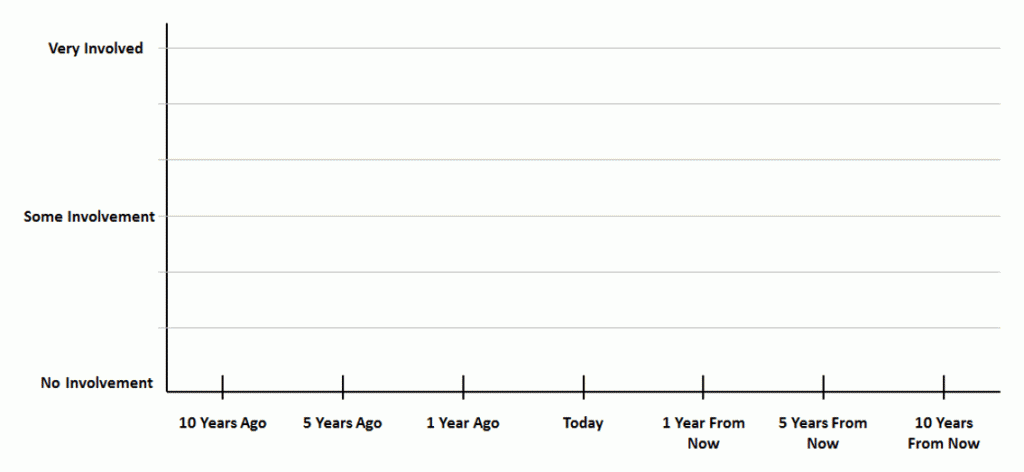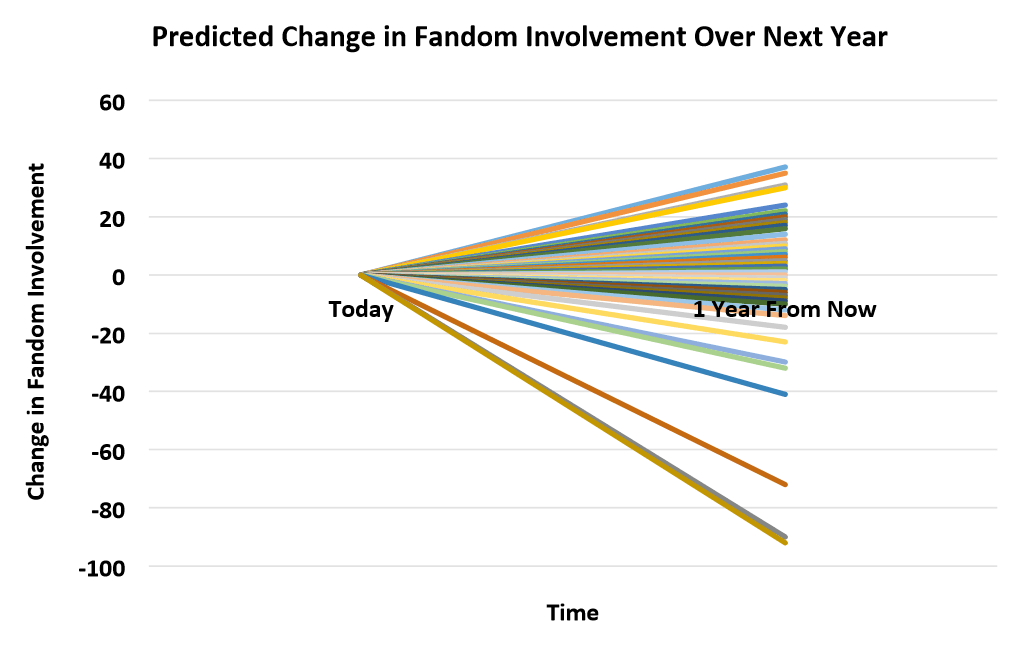In recent years, we’ve begun asking furries about their projected trajectory in the fandom. Furries are asked to draw, on the figure below, a line indicating how involved in the fandom they were at each of the points in time.
The first uses of this measure were pen-and-paper, requiring our research assistants to use rulers to assign numbers to the level of involvement at each of the seven time points on a scale from 0 to 100, with 0 representing “No Involvement” and 100 representing “Very Involved.” From there, our sample was split into three groups, based on age1 (see figure below).
The first noteworthy characteristic of the figure is that most furries are currently highly involved in the fandom. Another is the steady increase in involvement leading up to the present time; most furries indicate some past interest in furry content, which has steadily increased to the present day, regardless of age group. Perhaps most interesting, however, is furries’ projection of future involvement: despite evidence strongly suggesting that many furries leave the fandom by their 30s,2 most furries nevertheless assume that they will maintain their current level of fandom involvement into the future.
We also divided the data based on the length of time participants had been in the fandom (see figure below). A similar pattern was found, with the exception that furries who have been in the fandom for more than 10 years were, unsurprisingly, more involved in the fandom 10 years ago than furries who have not.3
On the graph below, we calculated the hypothesized trajectories for all 246 participants in one study. A straight, horizontal line indicates the belief that one’s involvement in the fandom will not change in the next year. An upward line indicates a belief that one’s involvement in the fandom will increase in the next year, while a downward line indicates a belief that one’s involvement in the fandom will decrease in the next year. With only a few exceptions, most furries indicated that they expected their involvement in the fandom to stay about the same or increase in the future.4
One of the most difficult samples to obtain is a sample of furries who have left the fandom. While we know that many furries do eventually leave the fandom, we have little about why they do. Given the difficulty of studying furries who have already left the fandom, the next best thing may be to identify furries who anticipate leaving the fandom. In fact, furries’ estimates about their anticipated future trajectory positively correlate with their presently-felt identification with the furry community. To put it another way: furries who plan to become less involved in the furry fandom are already identifying less with the furry community.5
In future studies (including our ongoing longitudinal study), we hope to test the accuracy of furries’ predictions about their future involvement and to see whether or not expectations of reduced future involvement predict leaving the fandom. To date, we’ve asked furries in this longitudinal study, over two periods with a year separating them, to indicate how positively or negatively they felt about the fandom on a scale from 0 to 100, with 0 indicating “Very Negative,” 100 indicating “Very Positive,” and 50 indicating “Neither Negative Nor Positive.” There are two competing hypotheses: on the one hand, the data above suggest that furries become more involved in the fandom and anticipate remaining involved in the fandom, which may mean that their attitude toward the furry fandom should become more positive over time. Moreover, psychological theories (e.g., social identity theory) suggest that we are biased to see our groups in a positive manner, which may also lead to more positive attitudes over time. On the other hand, as a person spends more time in the fandom, it may be the case that, like in relationships, they lose the “rose-colored glasses” that bias their perception, and become aware of less desirable aspects of the fandom, which may reduce their evaluation of the fandom over time.
When these competing hypotheses were tested, the data seemed to support the second one: furries in Wave 1 rated the fandom 78.8/100 on average, while the same furries rated the fandom nearly ten points lower, at 69.8/100 approximately one year later, a difference that was statistically significant.6
Put simply: furries were more likely to see the fandom less positively the more time they spent in it. However, it’s important to remember that furries in Wave 2 did not rate the fandom negative—just “less positive,” supporting the idea that furries “lose the rose-colored glasses,” rather than “starting to hate the fandom.” These findings may contribute to our understanding of why furries may eventually choose to leave the fandom, as having a decreasing opinion of the fandom may make furries less motivated to devote time and energy to it. Ultimately, future research on this subject is needed to test such mechanisms.





Recent Comments